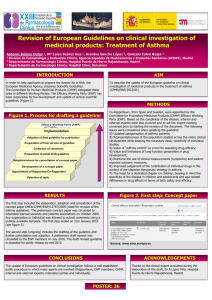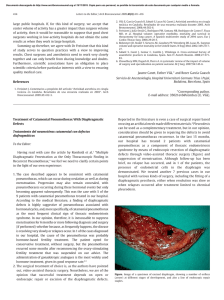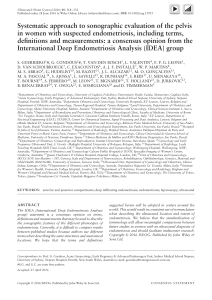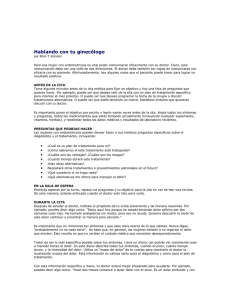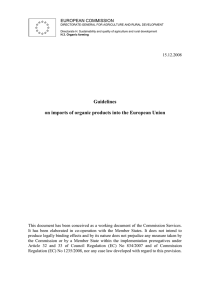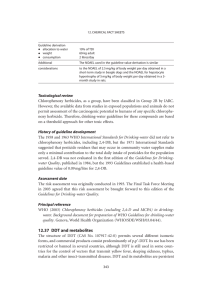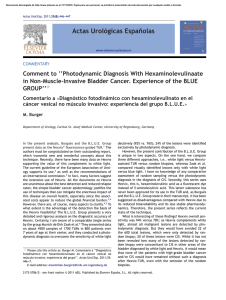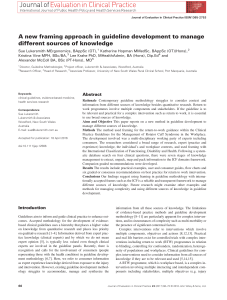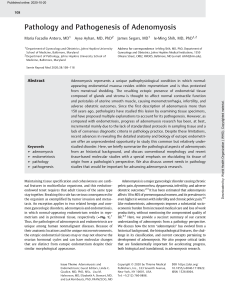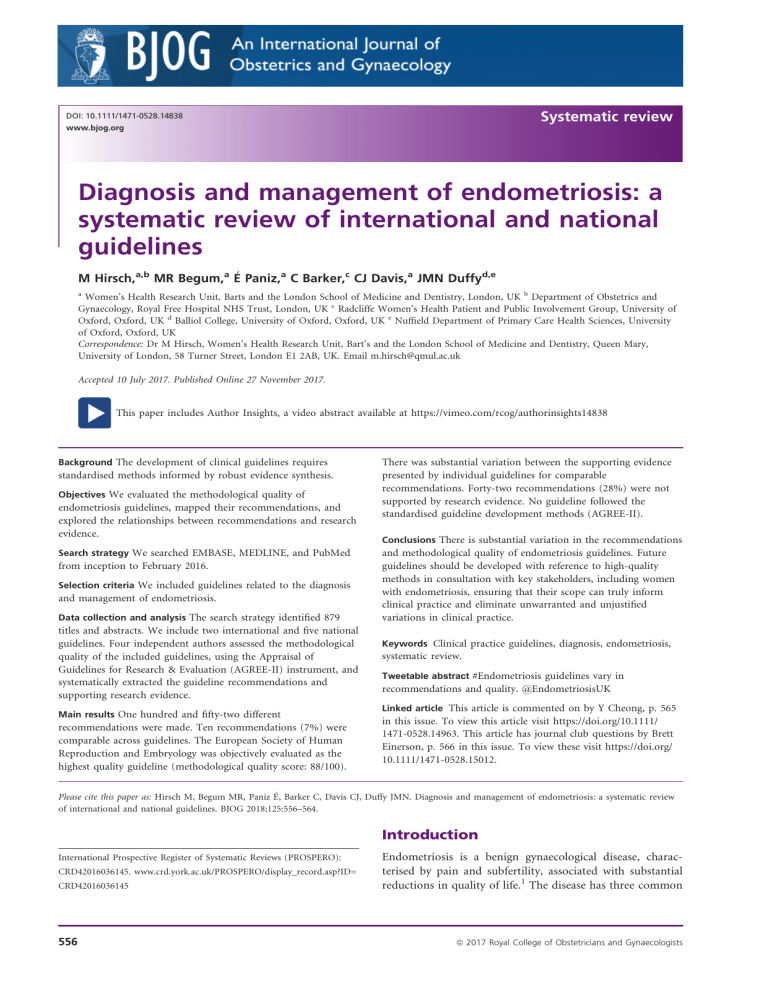
Systematic review DOI: 10.1111/1471-0528.14838 www.bjog.org Diagnosis and management of endometriosis: a systematic review of international and national guidelines Paniz,a C Barker,c CJ Davis,a JMN Duffyd,e M Hirsch,a,b MR Begum,a E a Women’s Health Research Unit, Barts and the London School of Medicine and Dentistry, London, UK b Department of Obstetrics and Gynaecology, Royal Free Hospital NHS Trust, London, UK c Radcliffe Women’s Health Patient and Public Involvement Group, University of Oxford, Oxford, UK d Balliol College, University of Oxford, Oxford, UK e Nuffield Department of Primary Care Health Sciences, University of Oxford, Oxford, UK Correspondence: Dr M Hirsch, Women’s Health Research Unit, Bart’s and the London School of Medicine and Dentistry, Queen Mary, University of London, 58 Turner Street, London E1 2AB, UK. Email m.hirsch@qmul.ac.uk Accepted 10 July 2017. Published Online 27 November 2017. This paper includes Author Insights, a video abstract available at https://vimeo.com/rcog/authorinsights14838 Background The development of clinical guidelines requires standardised methods informed by robust evidence synthesis. Objectives We evaluated the methodological quality of endometriosis guidelines, mapped their recommendations, and explored the relationships between recommendations and research evidence. Search strategy We searched EMBASE, MEDLINE, and PubMed from inception to February 2016. Selection criteria We included guidelines related to the diagnosis and management of endometriosis. Data collection and analysis The search strategy identified 879 titles and abstracts. We include two international and five national guidelines. Four independent authors assessed the methodological quality of the included guidelines, using the Appraisal of Guidelines for Research & Evaluation (AGREE-II) instrument, and systematically extracted the guideline recommendations and supporting research evidence. Main results One hundred and fifty-two different recommendations were made. Ten recommendations (7%) were comparable across guidelines. The European Society of Human Reproduction and Embryology was objectively evaluated as the highest quality guideline (methodological quality score: 88/100). There was substantial variation between the supporting evidence presented by individual guidelines for comparable recommendations. Forty-two recommendations (28%) were not supported by research evidence. No guideline followed the standardised guideline development methods (AGREE-II). Conclusions There is substantial variation in the recommendations and methodological quality of endometriosis guidelines. Future guidelines should be developed with reference to high-quality methods in consultation with key stakeholders, including women with endometriosis, ensuring that their scope can truly inform clinical practice and eliminate unwarranted and unjustified variations in clinical practice. Keywords Clinical practice guidelines, diagnosis, endometriosis, systematic review. Tweetable abstract #Endometriosis guidelines vary in recommendations and quality. @EndometriosisUK Linked article This article is commented on by Y Cheong, p. 565 in this issue. To view this article visit https://doi.org/10.1111/ 1471-0528.14963. This article has journal club questions by Brett Einerson, p. 566 in this issue. To view these visit https://doi.org/ 10.1111/1471-0528.15012. Barker C, Davis CJ, Duffy JMN. Diagnosis and management of endometriosis: a systematic review Please cite this paper as: Hirsch M, Begum MR, Paniz E, of international and national guidelines. BJOG 2018;125:556–564. Introduction International Prospective Register of Systematic Reviews (PROSPERO): CRD42016036145. www.crd.york.ac.uk/PROSPERO/display_record.asp?ID= CRD42016036145 556 Endometriosis is a benign gynaecological disease, characterised by pain and subfertility, associated with substantial reductions in quality of life.1 The disease has three common ª 2017 Royal College of Obstetricians and Gynaecologists A systematic review of endometriosis guidelines manifestations, including peritoneal endometriosis, ovarian endometriosis, and deep infiltrating endometriosis. The disease was first described in 1860, yet the aetiology and pathogenesis remain poorly understood.2 Treatment strategies vary significantly between disease severity and the presenting symptoms of pain and/or subfertility.3 These challenges have resulted in multidirectional research, with difficulties developing accurate diagnostic tests or effective therapeutic interventions because of variation and a lack of co-ordination along the research pipeline.4 This variation limits the comparability of research to inform patient care through evidence synthesis in the context of guideline formation and patient information.5 Guidelines are systematically developed statements based on the synthesis of the best research evidence.6 Their purpose is to improve patient care by informing clinical practice, reducing unwarranted variation, and expediting the implementation of effective interventions.7,8 The generation of robust guideline recommendations requires standardised guideline development methods, including stakeholder engagement, quality assessment of research evidence, and consensus methods. The methodological quality of guidelines has been reported to be inconsistent.9–11 Appropriate methodologies and rigorous strategies in the guideline development process are important for the successful implementation of the guideline recommendations.12,13 Previous comparisons of national endometriosis guidelines were limited by scope, setting, and did not map recommendations and supporting evidence across individual guidelines.14 We evaluated the methodological quality of endometriosis guidelines, mapped their recommendations, and explored the relationships between recommendations and research evidence. Methods Sources A protocol with explicitly defined objectives, criteria for guideline selection, and approaches assessing outcome selection was developed and registered with the International Prospective Register of Systematic Reviews (CRD42016036145). This review is reported in accordance with the Preferred Reporting Items for Systematic Reviews and Meta-analyses (PRISMA) statement.15 Search terms were generated in consultation with healthcare professionals, researchers, and women with endometriosis. We searched EMBASE, MEDLINE, and PubMed, from inception to February 2016 (Appendix S1). We used the following search terms: consensus; endometrio*; endometriosis; guidance; and guideline. Guideline selection We organised the extracted guidelines and removed duplicates. Two reviewers (MB and MH) independently screened ª 2017 Royal College of Obstetricians and Gynaecologists the full content of guidelines to assess eligibility, using a piloted data extraction tool. Any discrepancies between the reviewers were resolved by discussion. We included guidelines reporting recommendations for practice related to the diagnosis or management of endometriosis. We excluded guidelines for the following reasons: local or regional guideline; non-English language publication; and a more recent guideline available from the same authority. Guideline characteristics Two independent reviewers (MB and MH) extracted information, including: country of origin; year of publication; consensus method; stakeholders involved; disease area examined; description of database search; search terms used; language restriction; dates of searches; inclusion/exclusion criteria; and quality assessment instrument.16 Recommendations for clinical practice and supporting research evidence Two independent reviewers (MB and MH) extracted and mapped the recommendation to five pre-specified domains: diagnosis; medical management for pain; surgical management for pain; medical management for infertility; and surgical management for infertility. References supporting clinical recommendations were retrieved and categorised according to the hierarchy of medical evidence: cochrane review; systematic review; randomised control trials; non-randomised control trials; expert opinion; and no reference. Discrepancies were resolved by discussion. Assessment of methodological quality Four reviewers (MB, JD, MH, and EP) underwent training in the use of the quality assessment instrument, Appraisal of Guidelines for Research & Evaluation II (AGREE-II).15 Each reviewer independently assessed the quality of all included guidelines using the AGREE-II instrument. This validated assessment instrument contains 23 items grouped into six quality domains, with a seven-point Likert scale score, anchored between 1 (strongly disagree) and 7 (strongly agree), for each item.17 In addition, we assessed each guideline against six features of systematic review methodology: named database search; clearly defined search terms; language restrictions; dates of search; detailed search strategy; description of inclusion/exclusion criteria; and14 discrepancies were resolved by discussion.16 Analysis A total guideline score was calculated by the summation of its domains and standardised using a prescribed equation.17 Guidelines were categorised in to low quality (0–33%), moderate quality (34–66%), and high quality (67–100%). 557 Hirsch et al. Tabulation and data Descriptive statistics were calculated for all domains (median; range; and interquartile range, IQR). We mapped the data for clinical recommendations, their supporting research evidence, and variation in clinical recommendations. The tables, appendices, and subcategories of presented information were developed in consultation with researchers, healthcare professionals, and women with endometriosis, within an iterative process. We subcategorised interventions according to the presenting symptom: pain or subfertility. Following this, interventions were further categorised to medical and surgical interventions by: disease severity; disease location; adjuncts to surgical management; and alternative treatments. Results Guideline search and selection The search strategy identified 879 titles and abstracts. We screened 583 titles and abstracts following the exclusion of 296 duplicate records (Figure 1). We included two international and five national guidelines: American College of Obstetricians and Gynecologists (ACOG); Australasian Certificate of Reproductive Endocrinology and Infertility Consensus Expert Panel on Trial Evidence (ACCEPT); College National des Gynecologues et Obstetriciens Francßais (CNGOF); European Society of Human Reproduction and Embryology (ESHRE) Management of women with endometriosis; National German Guideline (S2k) Diagnosis and Treatment of Endometriosis (NGG); Society of Obstetricians and Gynaecologists of Canada (SOGC); and World Endometriosis Society (WES) Consensus on current management of endometriosis.24 Guideline characteristics The included guidelines were published between 2006 and 2014.18–24 Five of the guidelines were applicable to the diagnosis and management of pain and subfertility associated with endometriosis.18,20–23 Two guidelines reported narrower scopes: the ACCEPT guideline addressed the management of subfertility associated with endometriosis and the WES guideline made recommendations with regards to the management of endometriosis.19,24 Between 15 and 56 individuals were involved in guideline development. Between one and four different Figure 1. Flow of included guidelines. 558 ª 2017 Royal College of Obstetricians and Gynaecologists A systematic review of endometriosis guidelines stakeholder groups assisted in the development of the included guidelines. Three guidelines were developed in collaboration with women with endometriosis.21,22,24 Two guidelines did not report the geographical location of their developers,18,20 and one guideline was developed by individuals living in a single country.23 All guidelines developed recommendations relevant to high-resource settings only.25 Two guidelines explicitly defined a consensus development method, including the nominal group technique and modified Delphi method.19,21 No guideline described a detailed search strategy to identify research evidence for use in recommendation formation. Five guidelines described methods to quality assess the research evidence.18,19,21,23,24 Recommendations for clinical practice One hundred and fifty-two recommendations were identified and arranged into six clinical practice domains: Diagnosis (36 recommendations); Medical management for pain (30 recommendations); Surgical management for pain (39 recommendations); Assisted reproductive techniques for infertility (12 recommendations); Surgical management for infertility (22 recommendations); and Alternative treatments for pain and infertility (13 recommendations). Ten recommendations (7%) were comparable across the included guidelines (Tables 1 and 2, and Tables S1–S4). Recommendations often varied across guidelines: for example, the ACOG and NGG guidelines stated different recommendations regarding the use of adjuvant hormonal therapy following the surgical management of endometriosis. The ACOG guideline recommended the use of postoperative gonadotrophin-releasing hormone analogues for the treatment of pain, whereas the NGG guideline does not recommend their use. Thirty-six recommendations regarding the diagnosis of endometriosis were made across the included guidelines. Four recommendations were described by all guidelines, including: Biomarkers are not recommended for the diagnosis of endometriosis; Histological confirmation is recommended for the diagnosis of mild to moderate endometriosis (Table 2); Histology is recommended to confirm diagnosis; and Transvaginal ultrasound imaging is recommended for the diagnosis of endometrioma (Table S1). Seventeen recommendations cited no research evidence or only cited expert opinion. Thirty recommendations regarding the medical management of endometriosis were made across the guidelines. Three recommendations were described by all guidelines: The combined oral contraceptive pill is recommended for endometriosis associated pain; Progestagens are recommended for endometriosis associated pain; and Gonadotropin-releasing hormone analogues are recommended for endometriosis associated pain (Table S4). The strength of recommendations varied across the included guidelines (Table S1). Three recommendations cited no research evidence or only cited expert opinion. Twenty-one recommendations were made with regards to the surgical management of infertility associated with Table 1. Guideline recommendations for the diagnosis of endometriosis Biochemical Surgical • Imaging • • Symptoms • • • • • Surgical • • • • • Biochemical Symptoms • • • • • Endometrioma Examination • • • • • • • • Imaging • • Examination • • • Surgical Imaging • Severe endometriosis Biochemical Guideline ACOG (2010)18 CNGOF (2006)19 ESHRE (2014)16 NGG (2014)21 SOCG (2010)22 Examination Symptoms Mild/moderate endometriosis • • • • • • • • • • • • • • ge National des Gyn ACOG, The American Congress of Obstetricians and Gynecologists (2010); CNGOF, Colle ecologues et Obst etriciens Francßais (2006); ESHRE, European Society of Human Reproduction and Embryology (2014); NGG, National German Guideline: Guideline for the Diagnosis and Treatment of Endometriosis (2014); SOGC, The Society of Obstetricians and Gynaecologists of Canada (2010). •: Recommendations. *World Endometriosis Society (2013)17 and Australasian CREI Consensus Expert Panel on Trial Evidence (2012)19 provide no recommendations for the diagnosis of endometriosis. ª 2017 Royal College of Obstetricians and Gynaecologists 559 Hirsch et al. Table 2. Level of evidence supporting recommendations Guideline Level of evidence Cochrane review Systematic review Diagnostic accuracy trial Example 1. Biomarkers should not be used to diagnose endometriosis ACOG (2010)18 • CNGOF (2006)20 • ESHRE (2014)16 NGG (2014)21 • • SOCG (2010)22 Example 2. Diagnostic laparoscopy and histopathology should be used to diagnose endometriosis ACOG (2010)18 CNGOF (2006)20 ESHRE (2014)16 NGG (2014)21 • • SOCG (2010)22 Expert opinion No reference • • • • • ge National des Gyn ACOG, The American Congress of Obstetricians and Gynecologists (2010); CNGOF, Colle ecologues et Obst etriciens Francßais (2006); ESHRE, European Society of Human Reproduction and Embryology (2014); NGG, National German Guideline: Guideline for the Diagnosis and Treatment of Endometriosis (2014); SOGC, The Society of Obstetricians and Gynaecologists of Canada (2010). •: Recommendation stated. World Endometriosis Society (2013)17 and Australasian CREI Consensus Expert Panel on Trial Evidence (2012)19 provide no recommendations for the diagnosis of endometriosis. endometriosis.26–28 A single recommendation was described by all guidelines: surgery improves fertility with endometriosis-associated subfertility. Four recommendations cited no research evidence or only cited expert opinion (Table S5). Recommendations relating to complementary and alternative interventions were infrequently discussed. Psychological interventions, for example mindfulness practice, were seldom reviewed (Table S4). Research evidence supporting recommendations The number of references cited in each guideline ranged from 0 to 211 (Tables S3–S5). The total number of Cochrane systematic reviews used within each guideline ranged from 0 to 25, and the number of randomised controlled trials used ranged from 0 to 28. Where available, we sought the original references used to generate recommendations and summarised the references and study design (Tables S3–S5). Four guidelines did not report a consensus method.18,20,23 Five guidelines reported the inclusion of multiple stakeholder groups;19,21–24 however, only three guidelines clearly reported the inclusion of women with endometriosis in the development of the guidelines.21,22,24 Quality assessment of the retrieved studies was described by five guidelines, with the assessment methods including: Grading of Recommendations Assessment, Development, and Evaluation; Canadian Task Force on Preventative Health Care; National Health and Medical Research Council; and United States Preventative Services Task Force. Two guidelines were assessed as high quality,21,24 four guidelines were assessed as moderate quality,18,19,22,23 and one guideline was assessed as low quality (Table S2).20 Guidelines were typically of high quality in the domains of clarity and presentation and scope and purpose. Guidelines were of moderate quality in the domains of stakeholder involvement and rigour of development. Guidelines were of low quality in the domains of applicability and editorial independence. Assessment of methodological quality A systematic review was described by the majority of the guidelines.18,19,21–24 No guideline explicitly described all six methodological features (Table 3). Three guidelines reported three features,18,19,23 whereas the CNGOF guideline reported no features. No guideline reported a detailed search strategy or described explicit inclusion or exclusion criteria for the evidence that they sought. 560 Discussion Main findings There is significant variation in endometriosis guideline quality and recommendations. One hundred and fifty-two unique recommendations were reported across seven guidelines, but only ten recommendations were comparable. ª 2017 Royal College of Obstetricians and Gynaecologists Scope Infertility management Pain management Infertility management Pain management Diagnosis Infertility management Pain management Diagnosis Infertility management Pain management Diagnosis Infertility management Pain management Infertility management Pain management Guideline (year) ACCEPT (2012)19 ACOG (2010)18 CNGOF (2006)20 EHSRE (2014)16 NGG (2014)21 SOGC (2010)22 Table 3. Guideline characteristics ª 2017 Royal College of Obstetricians and Gynaecologists Healthcare professionals (unclear) Women with endometriosis (unclear) Pharmaceutical employees (unclear) Researchers (20; Canada) Healthcare professionals (11; unclear) Women with endometriosis (unclear) Pharmaceutical employees (unclear) Researchers (21; Europe; five countries) Healthcare professionals (unclear) Women with endometriosis (1; one country) Pharmaceutical employees (unclear) Researchers (14; Europe; nine countries) Not reported Not reported Healthcare professionals (36; unclear) Women with endometriosis (unclear) Pharmaceutical employees (unclear) Researchers (unclear) Stakeholders (n; location) Not reported Not reported Nominal group technique Modified Delphi method Not reported Not reported Nominal group technique Consensus method Database: EMBASE; PubMed Search terms: reported Language: English Dates: not reported Detailed search strategy: not reported Inclusion/exclusion criteria: not reported Database: ACOG; CENTRAL; MEDLINE Search terms: not reported Language: English Dates: 1985–2010 Detailed search strategy: not reported Inclusion/exclusion criteria: unclear Database: not reported Search terms: not reported Language: not reported Dates: not reported Detailed search strategy: not reported Inclusion/exclusion criteria: not reported Database: CENTRAL; PubMed Search terms: not reported Language: not reported Dates: inception–January 2012 Detailed search strategy: not reported Inclusion/exclusion criteria: not reported Database: CENTRAL; MEDLINE; PubMed Search terms: not reported Language: not reported Dates: not reported Detailed search strategy: not reported Inclusion/exclusion criteria: not reported Database: CENTRAL; MEDLINE Search terms: not reported Language: English and french Dates: 1985–2010 Detailed search strategy: not reported Inclusion/exclusion criteria: not reported Identification of evidence Canadian Task Force on Preventative Health Care Not reported Grading of Recommendations Assessment, Development, and Evaluation (GRADE) Not reported United States Preventative Services Task Force National Health and Medical Research Council Quality assessment of evidence A systematic review of endometriosis guidelines 561 562 ACCEPT, Australasian CREI Consensus Expert Panel on Trial Evidence (2012); ACOG, The American Congress of Obstetricians and Gynecologists (2010); CENTRAL, Cochrane Central Register of Controlled Trials; CNGOF, Coll ege National des Gyn ecologues et Obst etriciens Francßais (2006); ESHRE, European Society of Human Reproduction and Embryology (2014); NGG, National German Guideline: Guideline for the Diagnosis and Treatment of Endometriosis (2014); SD, Standard deviation; SOGC, The Society of Obstetricians and Gynaecologists of Canada (2010); WES, World Endometriosis Society (2013). Grading of Recommendations Assessment, Development, and Evaluation (GRADE) Database: not reported Search terms: not reported Language: English Dates: 1985–2010 Detailed search strategy: not reported Inclusion/exclusion criteria: not reported WES (2013)17 Diagnosis Infertility management Pain management Healthcare professionals (unclear) Women with endometriosis (unclear) Pharmaceutical employees (unclear) Researchers (56; international; 17 countries) Unclear Quality assessment of evidence Guideline (year) Table 3. (Continued) Scope Stakeholders (n; location) Consensus method Identification of evidence Hirsch et al. Nearly a third of recommendations were either unreferenced or were supported only by expert opinion. No guideline followed the standardised approach to guideline development described within the AGREE-II guideline. The involvement of women with endometriosis varied significantly, funding sources and conflicts of interest were poorly described, and there was poor reporting of applicability and editorial independence. Strengths and limitations The strengths of this systematic review include its originality, robust search strategy, and methodological design. To our knowledge, this is the first study to systematically appraise the methodological quality and to map the recommendations of endometriosis guidelines. There was good agreement between all four reviewers, with discrepancies resolved quickly through discussion. We involved a woman with endometriosis in the design and delivery of our research. Our empirical evaluation is not without limitations. Methodological scoring has not been definitively associated with applicability and clinical practice implementation.17,29 We did not calculate weighted kappa values to explore agreement between authors, as the statistical level of agreement required in health research is unclear, and it is not currently recommended by the Cochrane Collaboration.16,30 We could have considered systematically reviewing the randomised controlled trials and systematic reviews to form a judgement on the appropriateness of guideline recommendations; however, this would be unlikely to yield substantial benefit in the context of the considerable resource allocation required. Interpretation Our findings justify the critical appraisal of endometriosis guidelines, especially in an area such as endometriosis management, where diagnosis and treatment strategies are deemed suboptimal.31 With differences in guideline development methods it is not surprising to find a paucity of comparable recommendations, with wide intra-guideline variation in the supporting research evidence. The observations and conclusions of this review are likely to be replicated across our specialty. Guidelines should be developed by searching, collecting, and collating evidence to make judgements using robust consensus methods. The methods to achieve this in an unbiased manner are clearly described in the AGREE-II criteria. Variation in methods to identify and assess the included evidence could contribute to the variation in guideline recommendations. A recent Institute of Medicine report on guideline development and their worth in modern clinical practice highlights widespread methodological limitations in formation.32 Consumers of endometriosis guidelines should be aware of their shortcomings, including a lack of stakeholder engagement, varied rigour of ª 2017 Royal College of Obstetricians and Gynaecologists A systematic review of endometriosis guidelines development, limited applicability, and suboptimal editorial independence. The development of guidelines without a standardised methodological process will lead to the omission of beneficial therapies, an increase in preventable harm, and suboptimal patient outcomes or experiences.9 Guideline development can be prohibited by the availability of research evidence to answer the questions raised.33 The quality of randomised trials is also variable, with variation in outcome collection and reporting being a serious hindrance to progress in our speciality.34,35 The development and use of a collection of well-defined, discriminatory, and feasible outcomes, termed a core outcome set, would help to address these issues.36,37 The Core Outcomes in Women’s and Newborn health (CROWN) initiative aims to optimise the collection and reporting of comparable data, improving the synthesis of evidence within clinical guidelines, to support coherent recommendations.36 Forty-six core outcome sets are in development; however, reproductive medicine and benign gynaecology are currently underrepresented.37 A core outcome set for endometriosis is currently in development.38 Four core outcome sets have been completed, including preterm birth.35,39 These findings remain consistent with a previous study reporting the low quality of guidelines for pain associated with endometriosis.14 Over the last decade, there has been limited progress in the development of endometriosis guidelines. Most guidelines were of low quality for the domain ‘applicability’. This domain obtained remarkably low scores, as most guidelines did not discuss the topics of practical implementation, barriers to application, costs, and auditing criteria. These findings are of concern given the significant resources required to generate an ever-increasing body of guidelines.40 Future endometriosis guidelines should pay close attention to implementation. The development of guidelines is a resource-intensive process with eight different organisations developing endometriosis guidelines. A coordinated approach to guideline development would have clear benefits for professionals, researchers, and women with endometriosis. A single guideline, following methods described in the AGREE-II instrument, would reduce the unwarranted and unjustified variations in clinical practice, and would improve clinical outcomes. We urge guideline development groups to work collaboratively in order to secure the maximum efficiency and quality through the process.41 can truly inform clinical practice and eliminate unwarranted and unjustified variation. Disclosure of interests None declared. Completed disclosure of interests form available to view online as supporting information. Contribution to authorship MH, JMND, CJD, and CB were involved in the conception and design of the research protocol. MH designed the search strategy. EP, MRB, and MH undertook the screening of search results, paper retrieval, and study selection. EP, JMND, MRB, and MH extracted data and assessed the quality of the guidelines. Tables, figures, and appendices were designed by MH and JMND. Drafts of the manuscript were prepared by MH and JMND. All authors contributed to the drafts and final version of the manuscript and approved the final review. Details of ethics approval Not applicable. Funding This study received no funding. Acknowledgements We would like to thank David J. Mills for administrative and material support. Supporting Information Additional Supporting Information may be found in the online version of this article: Table S1. Medical intervention for pain associated with endometriosis. Table S2. Methodological quality of endometriosis guidelines. Table S3. Summarised guideline recommendations for the medical and surgical treatment of subfertility associated with endometriosis. Table S4. Summarised guideline recommendations for the medical and surgical treatment of endometriosis-associated pain. Table S5. Summarised guideline recommendations for the diagnosis of endometriosis. Appendix S1. Medline search strategy. Video S1. Author insights. & Conclusion There is substantial variation in the recommendations and methodological quality of endometriosis guidelines. Future guidelines should be developed with reference to high-quality methods, in consultation with key stakeholders, including women with endometriosis, ensuring that their scope ª 2017 Royal College of Obstetricians and Gynaecologists References 1 Rogers PA, D’Hooghe TM, Fazleabas A, Gargett CE, Giudice LC, Montgomery GW, et al. Priorities for endometriosis research: recommendations from an international consensus workshop. Reprod Sci 2009;16:335–46. 563 Hirsch et al. 2 Giudice LC, Kao LC. Endometriosis. Lancet 2004;364:1789–99. 3 de Ziegler D, Borghese B, Chapron C. Endometriosis and infertility: pathophysiology and management. Lancet 2010;376:730–8. 4 Hirsch M, Duffy JMN, Davies CJ, Nieves M, Khan KS. Diagnostic accuracy of cancer antigen 125 for endometriosis: a systematic review and meta-analysis. BJOG 2016;123:1761–8. 5 Hirsch M, Aggarwal S, Barker C, Davies C, Duffy JMN. Goggling endometriosis: a systematic review of information available on the internet. Am J Obstet Gynecol 2017;216:451–8.e1. 6 Grol R, Dalhuijsen J, Thomas S, Veld C, Rutten G, Mokkink H. Attributes of clinical guidelines that influence use of guidelines in general practice: observational study. BMJ 1998;317:858. 7 Neumann I, Brignardello-Petersen R, Wiercioch W, Carrasco-Labra A, Cuello C, Akl E, et al. The GRADE evidence-to-decision framework: a report of its testing and application in 15 international guideline panels. Implement Sci 2016;11:93. 8 European Comission. DG Health and consumer protection. Patient safety—making it happen!: luxembourg declaration on patient safety [online]. Luxembourg: European Comission. DG health and Consumer Protection, 2005. 9 Shaneyfelt TM, Mayo-Smith MF, Rothwangl J. Are guidelines following guidelines? The methodological quality of clinical practice guidelines in the peer-reviewed medical literature. JAMA 1999;281:1900–5. 10 Grilli R, Magrini N, Penna A, Mura G, Liberati A. Practice guidelines developed by specialty societies: the need for critical appraisal. Lancet 2000;355:103–6. 11 Burgers JS, Fervers B, Haugh M, Brouwers M, Browman G, Philip T, et al. International assessment of the quality of clinical practice guidelines in oncology using the Appraisal of Guidelines and Research and Evaluation Instrument. J Clin Oncol 2004;22:2000–7. 12 Grol R. Success and failures in the implementation of evidencebased guidelines for clinical practice. Med Care 2001;39 (8 Suppl 2):1146–54. 13 Grimshaw J, Russell I. Effect of clinical guidelines on medical practice: a systematic review of rigorous evaluations. Lancet 1993; 342:1317–22. 14 Appleyard TL, Mann CH, Khan KS. Guidelines for the management of pelvic pain associated with endometriosis: a systematic appraisal of their quality. BJOG 2006;113:749–57. 15 Liberati A, Altman DG, Tetzlaff J, Mulrow C, Gøtzsche PC, Ioannidis JP, et al. The PRISMA statement for reporting systematic reviews and meta-analyses of studies that evaluate health care interventions: explanation and elaboration. J Clin Epidemiol 2009;62:e1–34. 16 Higgins JPT, Green S, editors. Cochrane Handbook for Systematic Reviews of Interventions Version 5.1.0. The Cochrane Collaboration, 2011 [http://handbook-5-1.cochrane.org]. Accessed 05 March 2016. 17 AGREE Collaboration. Development and validation of an international appraisal instrument for assessing the quality of clinical practice guidelines: the AGREE project. Qual Saf Health Care 2003;12:18–23. 18 Practice bulletin no. 114: management of endometriosis. Obstet Gynecol 2010;116:223–36. 19 Koch J, Rowan K, Rombauts L, Yazdani A, Chapman M, Johnson N. Endometriosis and infertility – a consensus statement from ACCEPT (Australasian CREI Consensus Expert Panel on Trial evidence). Aust N Z J Obstet Gynaecol 2012;52:513–22. 20 www.cngof.fr/pratiques-cliniques/guidelines/apercu?path=RPC_end ometriosis_en.pdf&i=227 21 Dunselman GA, Vermeulen N, Becker C, Calhaz-Jorge C, D’Hooghe T, De Bie B, et al. ESHRE guideline: management of women with endometriosis. European Society of Human Reproduction and Embryology. Hum Reprod 2014;29:400–12. 564 22 Ulrich U, Buchweitz O, Greb R, Keckstein J, von Leffern I, Oppelt P, et al. National German Guideline (S2k): guideline for the diagnosis and treatment of endometriosis: long version – AWMF Registry No. 015–045. Geburtshilfe Frauenheilkd 2014;74:1104–18. 23 Leyland N, Casper R, Laberge P, Singh SS, SOGC. Endometriosis: diagnosis and management. J Obstet Gynaecol Can 2010;7 (Suppl 2):S1–32. 24 Johnson NP, Hummelshoj L, World Endometriosis Society Montpellier Consortium. Consensus on current management of endometriosis. Hum Reprod 2013;28:1552–68. 25 World Health Organization. Classification of a country’s resource setting [www.who.int/hinari/eligibility/en/]. Accessed 05 March 2016. 26 Duffy JMN, Arambage K, Correa F, Olive D, Farquhar C, Garry R, et al. Laparoscopic surgery for endometriosis. Cochrane Database Syst Rev 2014; (4):CD011031. 27 Jacobson T, Duffy JMN, Barlow D, Koninckx P, Garry R. Laparoscopic surgery for pelvic pain associated with endometriosis. Cochrane Database Syst Rev 2009; (4):CD001300. 28 Jacobson T, Duffy JMN, Barlow D, Farquhar C, Koninckx P, Olive D. Laparoscopic surgery for subfertility associated with endometriosis. Cochrane Database Syst Rev 2010; (1):CD001398. 29 Murthy L, Shepperd S, Clarke MJ, Garner SE, Lavis JN, Perrier L, et al. Interventions to improve the use of systematic reviews in decision-making by health system managers, policy makers and clinicians. Cochrane Database Syst Rev 2012; (9):CD009401. 30 McHugh ML. Interrater reliability: the kappa statistic. Biochem Med (Zagreb) 2012;22:276–82. 31 Vercellini P, Giudice LC, Evers JL, Abrao MS. Reducing low-value care in endometriosis between limited evidence and unresolved issues: a proposal. Hum Reprod 2015;30:1996–2004. 32 Institute of Medicine. Clinical practice guidelines we can trust [www. iom.edu/ /media/Files/Report%20Files/2011/Clinical-Practice-Guide lines-We-Can-Trust/Clinical%20Practice%20Guidelines%202011% 20Report%20Brief.pdf]. Accessed 05 March 2016. 33 Prusova K, Churcher L, Tyler A, Lokugamage AU. Royal College of Obstetricians and Gynaecologists guidelines: how evidence-based are they? J Obstet Gynaecol 2014;34:706–11. 34 Hirsch M, Duffy JMN, Kusznir JON, Davis CJ, Plana MN, Khan KS. Variation in outcome reporting in endometriosis trials: a systematic review. Am J Obstet Gynecol 2016;214(4):452–464. Pii: S0002-9378 (15)02587-9. 35 Duffy JMN, Hirsch M, Kawsar A, Gale C, Pealing L, Plana M, et al. Outcome reporting across randomised trials evaluating therapeutic interventions for pre-eclampsia: a systematic review. BJOG 2017;124:1829–1839. 36 Khan K. The CROWN initiative: journal editors invite researchers to develop core outcomes in women’s health. BJOG 2014;121:1181–2. 37 Duffy JMN, Rolph R, Gale C, Hirsch M, Khan KS, Ziebland S, et al. Core outcome sets in women’s and newborn health: a systematic review. BJOG 2017;124(10):1481–1489. 38 Hirsch M, Duffy JMN, Barker C, Hummelshoj L, Johnson N, Mol B, et al. A protocol for developing, disseminating, and implementing a core outcome set for endometriosis. BMJ Open 2016;6:e013998. 39 Van‘t Hooft J, Duffy JMN, Daly M, Williamson PR, Meher S, Thom E, et al. A core outcome set for evaluation of interventions to prevent preterm birth. Obstet Gynecol 2016;127:49–58. 40 Gagliardi AR, Brouwers MC. Do guidelines offer implementation advice to target users? A systematic review of guideline applicability. BMJ Open 2015;5:e007047. 41 Duffy JMN, Bhattacharya S, Herman M, Mol B, Vail A, Wilkinson J, et al. Reducing research waste in benign gynaecology and fertility research. BJOG 2016;124:366–9. ª 2017 Royal College of Obstetricians and Gynaecologists
